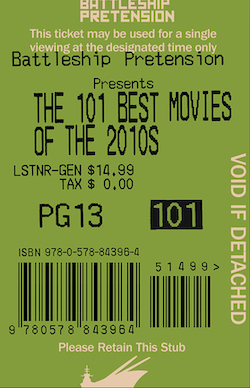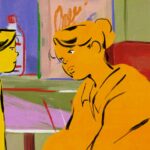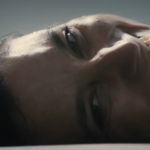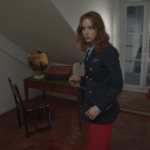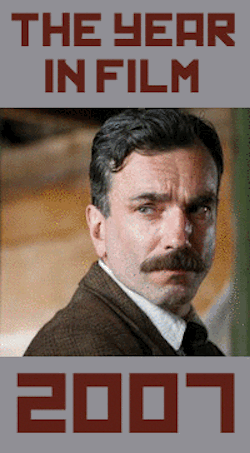La Notte: Waking Up the Dead, by Dayne Linford
Perhaps the most telling visual metaphor in the great Michelangelo Antonioni’s La Notte (1961) – newly restored and embarking on a fresh theatrical tour from Rialto – is the very first. In the credits, a series of long, rolling shots track downwards over the reflective façade of a modern hospital building. Following immediately from a two-shot featuring different sides of Milan, divided by the hospital, Antonioni is content to let us sit with this building, each slice of concrete flooring interrupting the crystal reflection of the city, adding a note of perverse insubstantiality to the image of its vast, solid expanse. It echoes a spool of film, reeling past us with frightening speed, showing virtually the same image, itself only remarkable in the knowledge of it as a film-esque reflection inside the reflection that is itself film, the interruptions of its literal concrete reality creating surrealism in the context of our image, interrupted suddenly by the loud gasp of Tommaso (Berhard Wicki), dying in the hospital. These twisted and ultimately immaterial self-reflections are the subject of Antonioni’s film: characters, and cameras, gazing into their own unknowable depths and coming away with virtually nothing.
This sequence introduces the two primary metaphors of the film – modern architecture and specifically photographic reflections, which themselves split from here into the two halves of the film. The first hour is dominated by Milan’s tall buildings and run-down neighborhoods, the second by the continual reflective paradoxes of billionaire businessman and self-proclaimed “artist” Gherardini’s (Vincenzo Corbella) palatial villa, featuring Antonioni favorite Monica Vitti as the minotaur at the labyrinth’s center. Similarly, each metaphor is also assigned to one of the two leads of the film – Lidia (Jeanne Moreau) and Giovanni (Marcello Mastroianni). He has just achieved literary success, even as their marriage flounders in its own familiarity.
Lidia’s world is dominated by the strong, powerful angles and shapes of modern architecture. Milan seems to wrap itself around her as she wanders through it, her momentary indiscretions and painful reflections placed against a backdrop of overhanging tunnels, dilapidated walls, and the slow, steady blink of a streetlight in the rain. Giovanni’s is similarly dominated by the reflection, not of mirrors, but of windows, whose duality as lens and mirror. Like the camera itself, he is alternately consumed by and incapable of acknowledging what surrounds him, his own reflection obscured and emptied whenever he seems ready to take a look.
The film, which is really an exploration of these twin visual metaphors as characterized, takes place through a single day in the life of this couple. Simultaneously, the day itself is both unbelievably eventful, full of parties, naps, city-wide wanderings, walks in memorable settings, attempted seductions, barely avoided assignations, and a dying friend, and also completely devoid of any real development. Giovanni particularly seems to observe everything that occurs with the same placid expression, unless of course considering his own behavior, which then gives way to such a confused character as to almost convey stupidity. He talks to the dying Tommaso with the same even-handed tone as he communicates with Gherardini, the billionaire whose dissolute party occupies the second half of the film and for whom Giovanni carries little more than bored contempt. He can’t rouse much more energy for Gherardini’s daughter, Valentina(Vitti), whom he attempts to seduce. His every urge seems simultaneously calculated, a mirrored façade to cover inner emptiness, and also completely unbidden, a welling of the irrepressible unconscious, suddenly destroying his ego’s barriers all at once, and he clearly cannot untangle them. Is he the id, pure personality barely constrained by modern social norms, an artistic cliche, or is he a mask, well-rendered and composed, as he says, not of ideas, but recollections?
Beyond that, where he does act rashly and strangely, he does so in the most bizarre circumstances, which do not convince or compel in any way. The first such act serves as the inciting incident of the film, such as it is – a girl down the hallway from their dying friend makes a clumsy, childish attempt to seduce Giovanni. She’s clearly incapacitated, given to psychotic urges, desperate and strange, yet Giovanni gives in before the nurses rush in upon them and kick him out. His expression afterwards is the first time we see that dumbfounded look, increasingly dominant as the film progresses, and it mirrors our own look as viewers. He can’t figure it, can’t understand whether this is an expression of libido, grief, listlessness, rapaciousness, boredom, rebellion, etc. In that look, every possible motive is examined and discarded, leaving him so confused he has to confess it to Lidia. Her reaction is to barely acknowledge it, to tacitly refuse the condemnation he expects, and to further refuse to speculate with him on his actions, which he clearly craves.
Instead, as they arrive at a party fêting him for the new novel, she simply drifts off to wander Milan’s streets, moving the film beyond the inciting incident into the second act, an assemblage of her observations of the city. Her wanderings confront symbols of modernity, masculinity, complacency, complicity, and ultimately violence. In a small moment echoing Giovanni’s own confusion, she sees a group of young men surrounding two of their number, engaged in a brawl. Approaching to interject, she finds herself merely observing, watching as one slowly gains advantage over the other and only speaking up as he continues to savagely beat him. The look on her face is unmistakable, and her observation carries the weight of emotion, something entirely lacking in Giovanni. Watching two young men she hardly knows, we see concern, interest, arousal, worry, and fear cross her features like a panopticon, before she flees from the returned, clearly sexual, gaze of the victor. Whereas Giovanni is lured into moral entrapment and personal confusion by his inability to empathize, Lidia is saved from potential compromise by the exact opposite impulse. Even as the city stands about her in mute, architectural columns, she registers great emotion, working through the dissolution of her marriage, and of her husband.
Though Giovanni makes up the content of their relationship, it’s Lidia’s reactions to him that make up the content of the film. Lidia, as she comes to realize, and as Tomasso has tried to impress upon her, had emptied herself to reflect Giovanni’s emptiness, or, perhaps initially, to fill it. Regardless, now emptied in the birthing of her husband’s success, a financial entanglement neither can escape, she and Giovanni, a vacuum in consumption and vacuousness, are both on the precipice, standing, successful, before their greatest personal loss and their most gaping moral hypocrisy, each rolling into the other and becoming indistinguishable.
But let’s not forget that first image, the first metaphor, and the implication of the filming process itself. Antonioni’s camera is also corrupted in this funhouse mirror, extending to the artistic endeavor generally. Giovanni must stand dumbfounded before the spectacle of his own name, emblazoned upon dozens of copies of his book and challenging his complete lack of self-definition. The same day, his attempted cuckolder accosts him not with an accusation or a challenge but with a quoted declaration that modern times are “vile and anti-philosophical”, further stating democracy means simply, “Take things as they come.” Giovanni’s reaction to this is one of the strangest moments in the film. He takes umbrage not at the quote, its aim, or its contents, but instead at the context in which it was initially written, apparently out of despair. It’s the single moment in the film where he seems to really take a stand, as it were.
However, the context of the confrontation in the film is Gherardini’s big party, where Giovanni has just failed in seducing Gherardini’s daughter. She had shone yet another light upon his emptiness in the process, and the cuckolder has just recently returned from his own failed attempt to seduce Giovanni’s wife. All are key to understanding this scene, amongst the wealth of Italy’s powerful, and their constant attempt to both make art payable and render it objective, a stand-in for the values apparently missing.
This passive quote, written in a moment of despair in the evocation of context is now forced to contrast violently with the easy whorishness of the society surrounding Giovanni and Lidia, which they have also bought into. The camera itself, portraying these modern palaces and all the pretty people who buy and sell each other amongst them, is also compromised, as unable as Giovanni to see past the labyrinthine reflections of Gherardini’s villa, occupied with the beauty of its own reflections, as if they stood for anything truly substantial on their own.
Only afterwards, when the truth is out, the most painful truth acknowledging not betrayal or hatred but simply the quiet apathy of death, when Giovanni and Lidia talk in the stark light of the morning, rendered ghostly white, does this constant double talk and image recede. Here, filmed in sharp, harsh contrast, there finally appears to be an honesty to the camera, or to the characters, engaging in a dialogue amongst themselves. But the truth is painful, and comfort preferable, and even this is elided. As the camera perversely drifts away from Lidia and Giovanni, Antonioni leaves us wondering if we got anywhere at all, or ever could.













